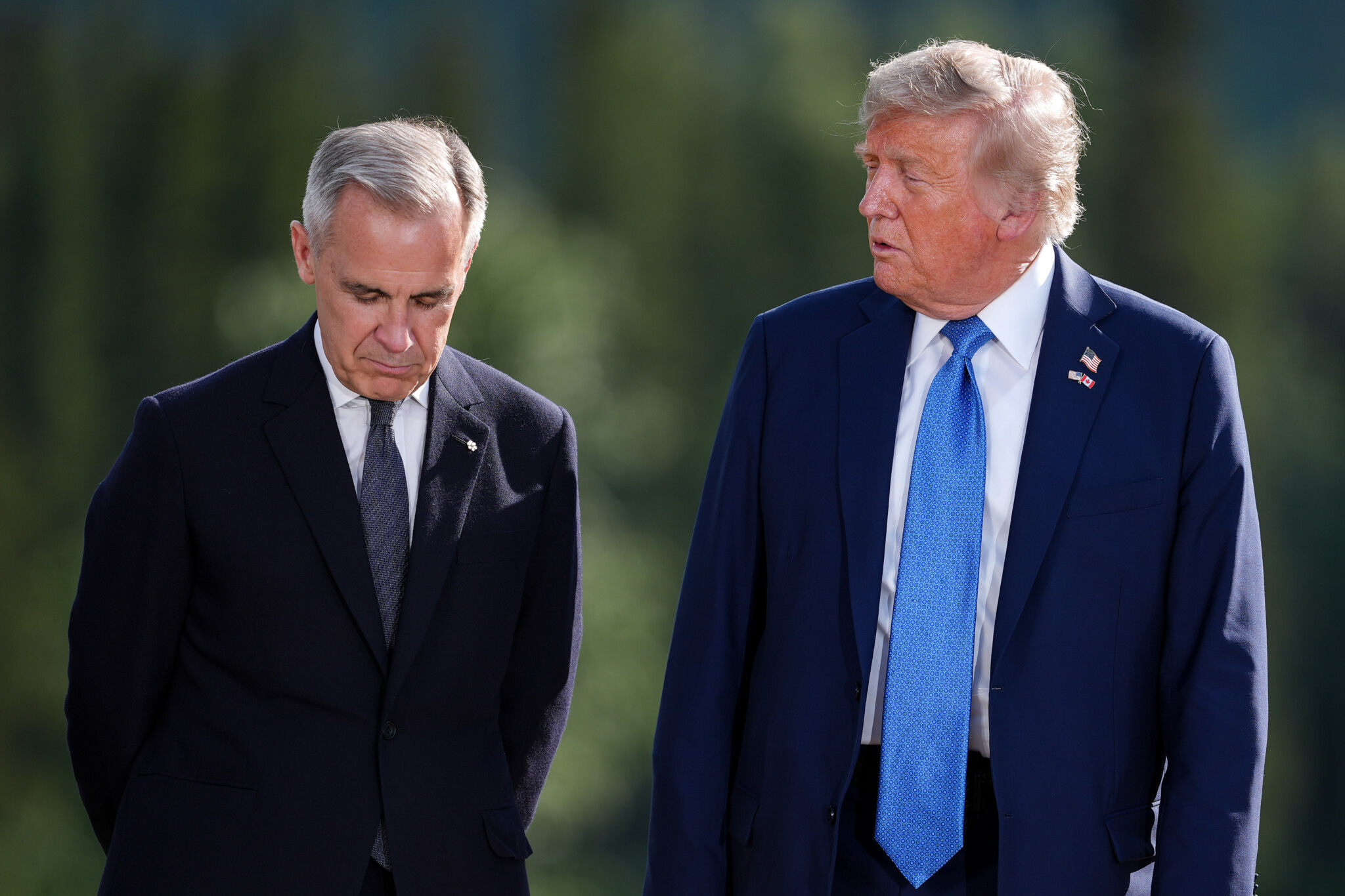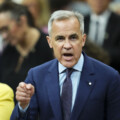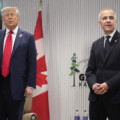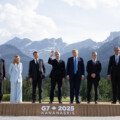In this week’s edition, we look at the growing tension between ambition and reality in the Carney government—with a focus on spending, resource development and U.S. relations. This includes late-breaking news on Friday that Donald Trump broke off talks on a new trade pact with Carney over Canada’s plan to start imposing a digital services tax on big U.S. tech companies at the end of this month. We also mark the passing of John McCallum, a rare figure who left an impact mark in both politics and economic thought, and run down some other highlights in policy and economics this week.
Ambition, meet arithmetic
It’s become crystal clear to everyone just how big Prime Minister Mark Carney’s ambitions really are.
It’s also clear he isn’t particularly interested in talking about the trade-offs that come with those ambitions.
Take his decision this week to join other NATO members in pledging to boost defence spending to at least 3.5 percent of GDP over the next decade, which is a massive commitment. That promise came just a few weeks after he had ramped up defence expenditures to 2 percent of GDP this year, an immediate $9-billion increase to the budget envelope.
At his press conference in The Hague following the NATO summit, half the questions (seven of 14) were about how he planned to pay for it. His response, in various forms: the economy will grow, the defence sector will benefit, and careful management of government operating costs going forward will create room. Also, any major trade-offs won’t need to be made until later in the decade.
“These will be net additive,” Carney said.
It’s worth remembering that Carney’s election platform already included $35 billion in new tax cuts and spending this year alone, with a projected deficit of $60 billion, higher than even Trudeau had been projecting.
Now the fiscal envelope is expanding further, and trying to square that fiscal circle has become a bit of a cottage industry in Ottawa.
Could it all be done through savings in operations? Maybe. Globe and Mail columnist Andrew Coyne thinks so.
Parliamentary Budget Officer Yves Giroux isn’t so sure. He told Bloomberg the deficit could hit $70 billion. Some economists say it could be closer to $90 billion.
We’ll know more by October, when the budget lands.
The Carney compromises
The fiscal question is just one of three big trade-offs facing the Carney government. The other two:
- How to square his championing of Canada’s resources while meeting climate goals and respecting Indigenous consultation
- How to resolve the U.S. trade dispute without seemingly sacrificing key industries or surrendering national sovereignty. In other words, how to make a deal with Trump while keeping your elbows up
These two tensions, plus the fiscal question, will drive the political story in the months ahead.
On the resource front, the bill to fast-track “nation-building” projects is now law. And the government is already moving to reduce opposition from Indigenous groups. “A key part of how we will make this successful is transforming how we think about Indigenous partnership in major projects,” Natural Resources Minister Tim Hodgson said this week in a speech to the Toronto Board of Trade.
Carney, meanwhile, is holding public roundtables with First Nations in Ottawa on July 17.
But pressure will build elsewhere. Environmental groups—and even some Liberal caucus members—will raise concerns about how quick he’s moving to bypass existing Liberal environment laws. And we’ll see that opposition escalate no doubt if the new law is used to further expand oil and gas development, which some Liberal lawmakers oppose. The honeymoon for Carney, where these tradeoffs can be brushed off, won’t last forever.
On the U.S. front, we’ll get clarity in the coming weeks. It’s all so unpredictable, and Trump upped the drama on Friday by breaking off talks over the Canadian government’s plan to start imposing a digital services tax.
That’s a new wrinkle in negotiations that up until now were focused on three other sectors: autos, steel, and aluminum. We’ll see how the digital sales tax issue unfolds. Don’t forget, Carney came to power by pledging to do two things: stand up to Trump and negotiate a new economic and security pact.
And let’s be honest. The digital services tax is hardly the hill we want to die on. Canada’s DST imposes a 3 percent tax on revenue earned by large businesses from digital activities, something we’ve always known would invite American retaliation. It’s seen by U.S. lawmakers as a cash grab of U.S.-based tech. The government had projected revenue from the tax of about $6 billion over five years starting in 2024-25. So it’s not a crazy amount of money.
As for the rest of the negotiations, as I wrote last week, the U.S. appears to be pushing for a hybrid quota system, where tariffs are removed up to a certain threshold, for these three sectors: autos, steel, and aluminum.
That’s exactly what Mexico is in the process of negotiating right now with the U.S., at least for steel. According to Bloomberg, the proposed quota would be limited to a volume of imports based on the average amount shipped to the U.S. from 2015 to 2017. Those amounts would be exempted from the current 50 percent tariff and face a 10 percent duty instead. And the Canadian government appears already to be telling stakeholders they may need to live with some type of U.S. tariff in any trade deal, according to a Globe and Mail story from Friday.
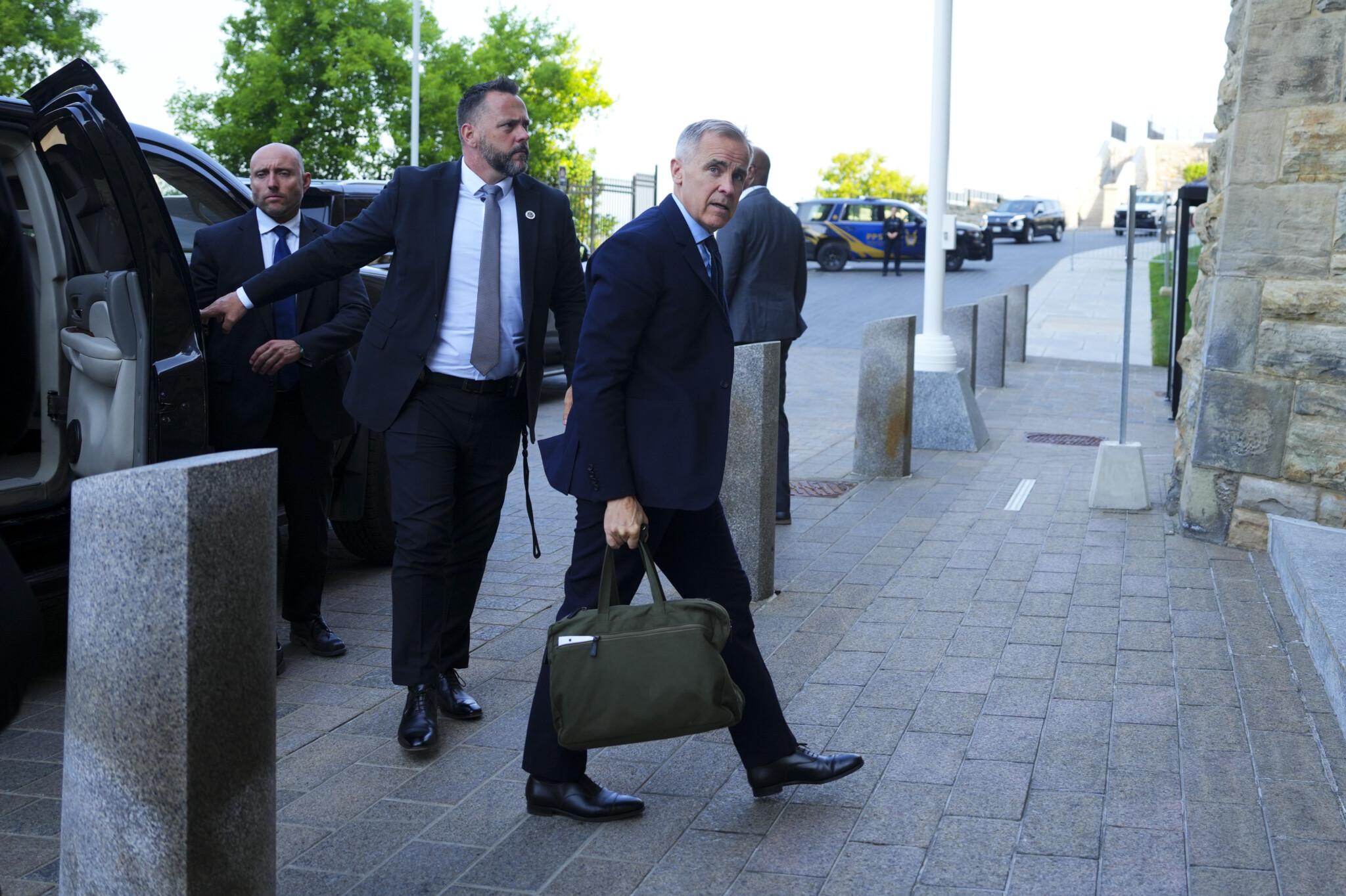
Prime Minister Mark Carney arrives to Parliament Hill in Ottawa on Wednesday, June 11, 2025. Sean Kilpatrick/The Canadian Press.
The economics of oil
The Carney government’s major projects fast-track bill is also casting a spotlight on the country’s oil sector, still one of the stronger corners of an economy facing stiff headwinds from tariffs and uncertainty.
The big question is whether the industry continues to be a significant driver of growth in the long term or becomes a legacy sector that remains extremely lucrative but is nearing its limits.
Right now, the status quo points to the latter. Two new forecasts this week show gradual, incremental growth over the next few years.
S&P Global released new oil sands forecasts that show production will rise by a solid 5 percent this year to a record 3.5 million barrels per day, before growth slows in coming years to reach a peak of 3.9 million by 2030.
The Alberta Energy Regulator’s forecast shows similar growth of about 2 percent annually through 2034.
Most of the gains are coming from fine-tuning existing assets and squeezing more out of current infrastructure rather than building new facilities—what the industry calls optimization.
Even if the sector could produce more, getting that oil to market is the next barrier. The new Trans Mountain pipeline has relieved short-term pressures, but capacity constraints are expected to re-emerge in just a few years.
Alberta Premier Danielle Smith is trying to rewrite the narrative. She says her goal is to double Canada’s oil and gas output, which would require a wave of new investments and more pipelines.
Plan A was to wait for a federal Conservative win. But with that falling through, Smith, like Carney, is seizing on the changing U.S. relationship to reframe oil as a national security issue and a key export diversification tool.
She’s especially keen on reviving the long-shelved Northern Gateway pipeline to the B.C. coast.
Smith told reporters this week that she expects there will soon be a new proposal for an oil pipeline to the West Coast to take advantage of the new two-year approval process for large infrastructure projects.
We’ll see.
Global markets are already oversupplied, and the long-term outlook for world oil prices is not exactly conducive to supporting the billions in new investment needed for major facilities, even if the market access puzzle for Canadian producers is solved.
It’s worth noting that the International Energy Agency is forecasting a 6 percent decline in upstream oil investment this year, which would be the first annual drop since 2020 and the largest since 2016.
Carney has voiced support for the oil sector. But he’s been carefully non-committal. Enbridge Inc., the pipeline company behind the Northern Gateway project, is trying to keep expectations low. The Canadian Press has produced a good story here on the limits of the private sector’s appetite for another pipeline.
For our part, The Hub has published a series of pieces this week on the viability, or not, of a new oil pipeline: here, here and here.
John McCallum’s quiet legacy
Late last weekend, I learned with a heavy heart of the passing of John McCallum, the long-time Liberal cabinet minister. After more than two decades in public life, he’s been widely and generously remembered for his political legacy. But it was as a formidable academic that I first came to know him.
In the late 1980s, he had been brought in by McGill to chair the economics department and help steer it out of a period of internal conflict. He held that post through most of my six years there, including a stint as a PhD student.
In fact, he passed away almost exactly 30 years after publishing his most influential scholarly work: a landmark paper showing that national borders significantly inhibit international trade flows. It became one of the most cited economics articles ever produced by a Canadian academic and helped launch an entire branch of study.
Economists Maurice Obstfeld and Kenneth Rogoff included his findings on their list of major puzzles in international trade, akin to the “home bias” puzzle in finance, where investors systematically favour domestic assets over foreign ones.
To our ears today, in this Trumpian world, McCallum’s conclusions sound counterintuitive. Aren’t we striving for more internal trade and less reliance on the U.S. market? Is he telling us we should be trading more with the U.S.?
The answer is no. In fact, the model actually provides a comforting insight for the current moment. It tells us that there are institutional, cultural, and societal ties that matter more than cold, calculated economic forces.
McCallum himself saw it as evidence of a deeper sovereignty that should embolden us. I asked him about it during an interview for Bloomberg in 2016:
“What that study showed—and it was a long time ago but the basic point still holds—is trade within a country, at least within our country, is a lot more intense than trade with other countries. Now, is that a problem? Not necessarily to the extent that the greater internal trade reflects greater ties from various associations, from kinship, from being a country. The extent to which it reflects the importance of trade barriers internationally, then you can look upon it as a problem. I’m not sure the evidence is fully in on that question, but I tend to regard it more as a positive thing—reflecting the things that bind together a nation.”
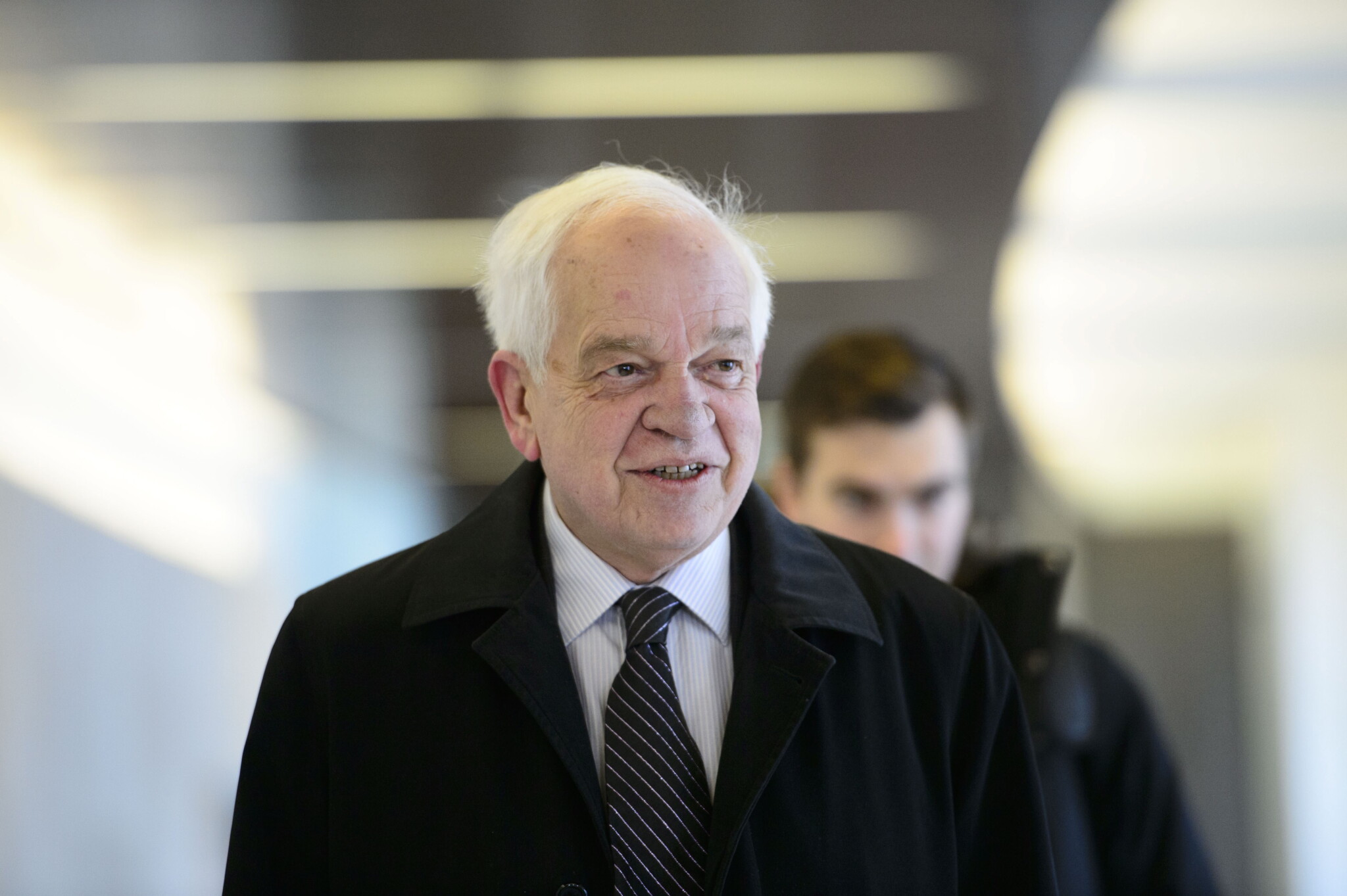
Canada’s ambassador to China, John McCallum, arrives to brief members of the Foreign Affairs committee regarding China in Ottawa on January 18, 2019. Sean Kilpatrick/The Canadian Press.
Assorted Links
Slowdown but no recession. Canada’s economy contracted marginally in April and May, shrinking by about 0.1 percent in each of those months, Statistics Canada reported this week. The data align with economists’ expectations for a mild contraction this spring, followed by stabilization over the summer and a return to growth by year-end. One caveat: the numbers were inflated by temporary election hiring. Also, sectors exposed to global trade are feeling the pain more acutely. Manufacturing output fell by 1.9 percent in April, the sharpest monthly decline since 2021. Still, while the economy is showing clear signs of stress from the tariffs and pervasive uncertainty, it’s still all very mild as far as downturns go.
Sticky inflation. Canada’s core inflation metrics remained stable in May but are still running hot enough to potentially delay further interest rate cuts from the Bank of Canada. According to a StatsCan release this week, headline inflation held steady at 1.7 percent, largely thanks to the recent removal of the consumer carbon tax. But closely watched core measures—which strip out volatile items—are still hovering around 3 percent, an uncomfortably high level for the central bank.
Rent relief, slowly. Canada’s renters are seeing some relief, with asking rents dipping slightly in key markets like Vancouver and Toronto. During the first three months of 2025, the average listed rent for a two-bedroom apartment in Vancouver fell by $270 from a year earlier, and is now sitting at $3,170. In Toronto, rents are down about $160 to $2,690. Still, rents are up about 50 percent on average in Canadian metropolitan areas since 2019.
Holding line on bank capital. Canada’s banking regulator is keeping its Domestic Stability Buffer—which applies only to the country’s six largest banks—at 3.5 percent of total risk-weighted assets, citing elevated systemic vulnerabilities. The buffer, introduced in 2018, is essentially a rainy-day reserve that can be drawn down during periods of financial stress. At 3.5 percent, it’s at an all-time high. The regulator’s intention is to safeguard Canada’s financial system from a major destabilizing event, but keeping the buffer relatively high is costing the economy billions of dollars in available credit. When OSFI cut the buffer at the start of the pandemic in 2020 to 1 percent, from 2.25 percent, it said the move would provide banks with about $300 billion of additional lending capacity. This week’s announcement came just as U.S. regulators moved in the opposite direction, easing capital rules for the largest U.S. lenders.
No more revenge. The Trump administration has dropped a controversial clause from its new budget that would have allowed the U.S. to unilaterally tax non-U.S. investors from countries it deems to be pursuing unfair tax policies, such as digital services taxes or the global minimum tax. Canada has adopted both of these measures, meaning Canadian investments in the U.S. were at theoretical risk. U.S. Treasury Secretary Scott Bessent said the G7 countries have now agreed to exempt U.S. companies from the global minimum tax framework.
